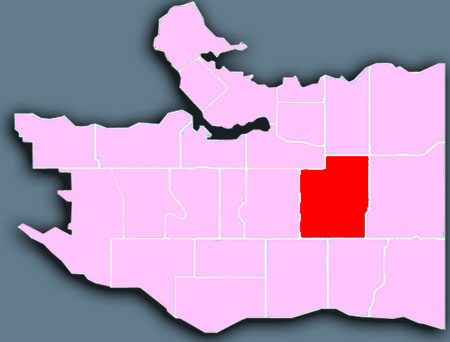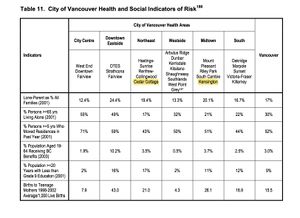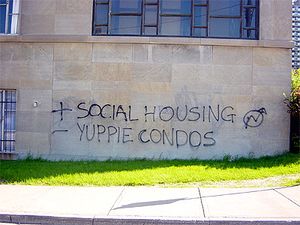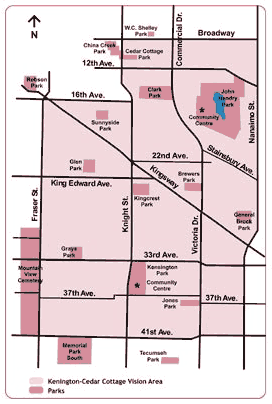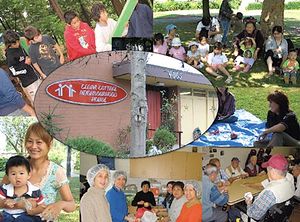Course:Geog350 2013/Kensington
Introduction
Kensington-Cedar Cottage is one of Greater Vancouver’s twenty-three neighborhoods. Cedar Cottage, located north of Kingsway to Broadway, between Clark and Knight Streets and Nanaimo Street; and Kensington, located south of Kingsway to 41st Avenue, between Fraser Street and Nanaimo Streets. One of the unique characteristics that define this neighborhood is found in the dynamic nature of those who live there; it is considered to be one of the more diverse neighborhoods comprised of mostly a younger crowd of working class immigrants. One of the emerging problems in the neighborhood has to do with the rising prices of real estate, which has made it very difficult for its community members to own houses. Kensington has suffered from issues of securing adequate and affordable housing, childcare, and transportation. We will explore these issues, particularly housing affordability in the Kensington area on this Wikipage. Housing prices have inflated marginalizing residents and affecting low income citizens. We will focus on this particular issue.
History
Kensington-Cedar Cottage has a brief history like Vancouver itself. Cedar Cottage gets it's name from a cabin that was once on a parcel of land located at either Kingsway and Thynne Road or the southwest corner of East 25th Avenue (later King Edward Avenue) and Thynne Road, 100 yards south of Kingsway.[1] Thynne Road later became Dumfries Street in 1910. The Cedar Cottage Nursery was the first development in the soon-to-be neighborhood. In 1891, The interurban line that connected Vancouver and New Westminster was established, including a stop at "Cedar Cottage", also known as "Epworth" at that time, opening up the area and attracting businesses.
Moses Gibson, a local proprietor and landowner, set up a dairy farm, known as the Gibson Ranch. It was one of a series of ranches along Kingsway. The land at the time was bush and old stumps, which may have been clear-cut circa 1900. In 1901, George Raywood built his Cedar Cottage Brewery at 1404 Kingsway, later known as “Benson’s Brewery”. Beer in bottles could be delivered to your home for $0.75/dozen pints.[1] The site later became a location of a Safeway grocery store.
From 1911-1917 sewers were built in the area and False creek flats were created. As the automobile grew in importance as a mode of transportation, Westminster Road was paved. It was named “Kingsway" after a thoroughfare in London, England, named in honor of King Edward VII. It became a major thoroughfare drawing even more businesses to the area. Businesses such as a new movie theatre showing silent films, a Bank of Hamilton, post office, hardware store, and a small roller coaster. The rollercoaster disappeared before 1913. Many industries flourished here such as a foundry, meat and food processing plants and other industrial factories.
“Kensington Heights” was created in the 1910s and grew in the 1920s. The area is home to Vancouver's only lake within city boundaries. Kensington-Cedar Cottage was amalgamated into Vancouver in 1929. In 1974, Knight Street bridge opened and became an arterial route. In 1983, Vancouver Community College, formerly at the old King Edward High school site at 12th and Oak, opened in the area. The school was built on top of China Creek and in 1988, $250,000 had to be spent on drainage pipes to remove creek water from the VCC campus. Kensington-Cedar Cottage is two separate neighborhoods joined by the City of Vancouver’s Community Visions process in 1997.[1]
Demographics & Neighborhood Characteristics
Kensington-Cedar Cottage (KCC) is an area covering 7.2 km2, located on the east side of Vancouver.
Population: According to the 2006 census, Kensington has a population of 54 870. Seniors aged 65 and over comprise 14% of the population and 40% are between the age of 20-44. The neighbourhood is full of young professionals and families.[2]
Languages: In 2001, the top languages spoken were approximately 37.8% of the total KCC population of 54 870 listed Chinese as a mother tongue, while 32.8% listed English. The next most common language spoken as a mother tongue was Vietnamese(5.5%) followed by Tagalog(5%) and Punjabi(3.9%). At 18%, the percentage of single parent family households is relatively high, compared to Vancouver’s average of 16%.[2]
Housing stats: According to Stats Can, low income households account for 27.5% of the neighborhood and 47% of housing are single detached homes. The neighborhood has several low apartment buildings as well as a few high-rise apartment buildings. The average value of owner-occupied private dwellings was $555 628; compared with a BC average of $418 703. Gross rent for the neighborhood was $847, while BC's average was $907. Percentage of rental households spending 30% or more of income on shelter was 37% compared with 29% of owner-occupied households spending income greater than 30% of income on shelter. Apartment duplexes make up the majority of housing here. Owner-occupied dwellings account for 63% of households as compared to the BC average of 70%. Renter-occupied households account for 37% of households as compared to the BC average of 30%.[2]
Employment and Income: 30 425 of the 45 950 residents partake in the labor force. There is a 66.2% participation rate and an unemployment rate of 6.8%, which is above the BC average of 6%. The average before tax income of all private households in 2005 was $62 210(after-tax: $54 450) and the median before tax income of all private households was $51 712(after-tax: $46 448). This is below the BC median income before tax of $62 600 in 2006.[2][3]
Neighbourhood Issues
Kensington-Cedar Cottage is one of Greater Vancouver’s twenty-three neighborhoods. One of the unique characteristics that define this neighborhood is found in the dynamic nature of those who live there; it is considered to be one of the more diverse neighborhoods comprised of mostly a younger crowd of working class immigrants. One of the emerging problems in the neighborhood has to do with the rising prices of Real Estate, which has made it very difficult for its community members to own houses. This problem, it seems is not limited to this neighborhood in particular within the Greater Vancouver area, but has affected the whole city being one of the least affordable cities in the world. Meanwhile, young professionals who cannot afford housing in other high-income based neighborhoods drive the prices up as the original inhibitors of the neighborhood are pushed out as a result. This is a significant issue because the heightened price of real estate actively threatens the diversity of the neighborhood. This is especially significant because as mentioned, the neighborhood is densely populated by immigrants with an income significantly lower than that of other neighborhoods. Low-income households make up 27.5% of the area’s population.
Multiculturalism and diversity fall at the core of the Canadian identity and especially the Canadian city. Vancouver is exemplary of a well-planned multicultural makeup, and thus remains to be a primary axis to city planners and politicians alike. Affordability and equality are key elements for voters, which had them address the issue of real estate prices and to compel parties to introduce tactics and programs to lower prices.
Housing Affordability
Kensington has a below average median income as compared to British Columbia as a whole and above average real estate prices. This means Kensington has a less affordable housing market compared to the median of BC.[2] Residents of Kensington already earn below average incomes making it harder for them to buy into one of the worlds most expensive real estate markets.[5]
Government zoning policies, such as Vancouverism, that are implemented to contain urban sprawl, lead to higher house prices and speculation in markets. As more people are vying to live in the same space, they bid up prices and investors are aware of this and buy homes in the hopes of selling at a higher price later, while also bidding up house prices themselves. Vancouverism means tall slim towers for density, widely separated by low-rise buildings, for light, air, and views. It also emphasizes many parks, walkable streets, public spaces and sustainable transit. This urban design is achievable through creative planning and it has improved the livability and desirability of Vancouver, including Kensington.[6]
The increased desirability of the city and neighborhood attracts investors, speculators and others seeking this lifestyle, which pushes up home prices as more money is chasing the same amount of housing stock. As home prices rise, it becomes less affordable for those already living in the neighborhood as rents increase, property taxes increase and affording real estate becomes more difficult. This increase in the cost of living pushes out or marginalizes the most vulnerable residents of the neighborhood elsewhere.
Housing affordability can be rated using a method referred to as the median multiple. That is the median house price divided by gross before-tax annual median household income. The higher the measure means the more unaffordable the housing market. Vancouver's median multiple was 9.5, with its median house price of $621,300 on a household income of $65,200. Kensington's median multiple as of 2005 is 10.74, with it's median house price of $555 628 on a household income of $51 712. A measure of 5.1 or greater places a neighborhood in the severely unaffordable category.[7]
According to a housing trends and affordability report, the Vancouver-area market was clearly in correction mode in 2012.[8] Home re-sales fell 23% from 2011 to the lowest level in 12 years if we exclude the recession in 2008 (the 2012 total, in fact, surpassed the 2008 level by less than 300 units or just 1.2%). Such weakness in the market tipped the pricing scale in favor of buyers. Following a spectacular run-up in the previous nine years, home prices fell across the board last year. By the fourth quarter, the Vancouver area was the only major market in Canada showing year-over-year price declines. The upside of this softening has been a lessening in the degree of unaffordability in the area. While Vancouver remains, by far, the least affordable market in Canada, homeownership costs eased noticeably in the latter half of 2012.[8] In the fourth quarter, price measures fell by 2.6 percentage points for detached bungalows, by 1.2 percentage points for condominium apartments, and by 0.8 percentage points for two-story homes.[8] Even with the decrease in housing prices in the fourth quarter of 2012, housing is still unaffordable for many in Kensington.
Gentrification
Causes: Gentrification occurs when new residents who disproportionately are young, white, professional, technical, and managerial workers with higher education and income levels replace older residents who disproportionately are low-income, working-class and poor, minority and ethnic group members, and elderly from older and previously deteriorated inner-city housing in a spatially concentrated manner, that is, to a degree differing substantially from the general level of change in the community or region as a whole. The definition hinges on economic, social, and population changes that cause physical changes to the neighborhoods.[9] First, a shift from manufacturing to services occurs with an accompanying reduction in the absolute demand for labor, particularly affecting the unskilled work force. This lowers the ability of low-income persons to pay rent. Second, increasing professionalization and concentration of management and technical functions creates additional higher-income demand for housing. These processes have spatial consequences. Lesser demand for blue collar jobs results and higher demand for professional service jobs in the central business districts happens. Neighborhoods adjacent to central business districts reflect these changes.[9]
External Forces: Global forces that have caused broad changes since world war II affect Kensington-Cedar cottage. The change of the Canadian economy from manufacturing based to services based has replaced many of the good-paying industrial jobs in KCC to low paying service sector jobs.
Predominant Land Use Patterns:Prevailing development patterns and corresponding government policies have favored new, low-density suburban development. Investment has corresponded to support automobile centered transit, although Vancouver has recently been investing, at the least, to maintain and improve it's public transit system. The strong dependence on the automobile and the absence of sufficient public transit alternatives have prevented many low- income families who cannot afford to own a vehicle from accessing jobs and even commercial centers in the suburbs. Cheap real estate and lack of economic control by residents help set the stage for gentrification.[10]
Government Policies:Local governments are understandably starved for revenue, especially discretionary income because property taxes come to them from the state with mandates for how the money must be spent. Because of the other constraints on their ability to raise taxes, the only way for local governments to capture more revenue is by trying to increase the sales taxes collected in their jurisdiction through increased retail sales. Not only do local governments receive little if any fiscal benefit from zoning for housing instead of other uses such as commercial use, it often costs more for local governments to provide public services (like schools, roads, water and sewer service) to new developments than the increase in revenue that more housing brings. The resulting situation is what many refer to as the "fiscalization of land use" or land use decisions which are not based on local needs, but on budgetary considerations alone.[10] Local governments have little incentive to encourage social housing.
Kensington-Cedar Cottage shows symptoms of the conditions ripe for gentrification. The neighborhood has a higher rate of renters and lower rate of owner-occupied dwellings than the average for Vancouver.[2] The higher rate of renters makes the neighborhood more susceptible to gentrifiers and speculators looking to take advantage of the lower than average rental rates and proximity to central business district jobs.[2] The ease of access to job centers via transportation routes, public transit and proximity appeal to the "return-to-city" crowd. Over the net few years, the Kensington-Cedar Cottage will see improved transit options. Improvements include an expanded station area for the Broadway/Commercial SkyTrain in 2016, improved capacity (train length, frequency) for the Expo, increased traffic when the Evergreen Line is completed in 2016, potential extension of the Millennium Line westward, and redevelopment in the vicinity and potential redevelopment of key sites (e.g. Safeway)."[11] High and increasing levels of metropolitan congestion contribute to the demand for affordable housing close to the CBD, this demand is compounded when mixed with improved transit and accessibility to job centers. The most important ingredient for gentrification is comparatively low housing values. The lower housing values of Kensington compared to the average for Vancouver along with it's proximity to the CBD and the plans to build more transit in the area are priming the area for the conditions of the evolvement of gentrification in the area.[11]
Revitalization Without Displacement
In economically depressed neighborhoods, improving access to affordable, good quality housing can boost the health, quality of life, and future prospects of local residents. It can also stimulate community economic development and physical as well as social neighborhood renewal.[12] If these initiatives are achieved successfully then the neighborhood would face a new challenge: Gentrification. The positive attributes of the neighborhood, such as proximity to downtown make Kensington susceptible to the woes of gentrification. The comparatively low housing values make Kensington attractive to young professionals and works to drive up prices. Because they realize the potential to attract higher-income tenants, rental property owners fix up their properties and increase the rents. This, in turn reduces the amount of affordable housing in the area and displacing some of the lower income tenants. People also buy and fix up homes in the area contributing to rising housing prices. Government social housing can make the difference because, despite all the efforts and positive work of residents and community-based organizations, they alone cannot augment or preserve the stock of affordable housing without policy direction and resources from senior and local residents.[12]
Social Housing
Multiculturalism
Multiculturalism should be one of the concepts urban planners must take into account in designing the city, as it is part of social sustainability. Vancouver attracts many immigrants every year who come from different cultures and backgrounds, and who either move regardless of where those of the same community they belong to live. There are also those who choose to be close to other immigrants, especially those who come from similar backgrounds. The reasons behind choosing so may be obvious; those include "common interests, religions, and languages" [4] (38-39) For this reason, the concept of "Visible minority neighbourhoods" are not foreign to the city of Vancouver. Neighbourhoods that fit the category are home to a single minority group that makes up at least 30% of that neighbourhood's population.
Where there is not sufficient data which breaks down the population of Kensington-Cedar Cottage, there is evidence that 37.8% of its residents are Chinese speakers (mother tongue) which suggests that the neighbourhood could take on the title "Visible minority neighbourhood".[2] However it is important to know that there are other concentrations of immigrants within the same neighbourhood which include Vietnamese, Filipinos, and Punjabis which all together comprise almost 15% of the population. [2]
These ethnic groups through their proximity to one another create social networks, otherwise known as spatial concentration. [4] This effect has both positive and negative aspects. Especially at the beginning of the transition, new immigrants can benefit from those communities of the same background in their adaptation process. Older settlers can help new comers to find jobs. However "on the other hand, spatial segregation in conjunction with poverty can lead to long-term social exclusion." [4] This spatial concentration triggers concern when the neighbourhood is a low-income neighbourhood where low-income immigrants may not have access to affordable housing, community services and amenities, and good employment opportunities. [4]
Although there is no gentrification per se in Kensington-Cedar Cottage, the sky-rocketing prices of the housing market shows to threaten the diversity of the neighbourhood. Studies show that when this happens, low-income immigrants tend to move to the suburbs. [4]
Cedar Cottage Neighbourhood House
Cedar Cottage Neighbourhood House is one of the key features in the Kensington-Cedar Cottage Neighbourhood. Established in 1950, Cedar Cottage Neighbourhood House serves somewhat like a community center which aspires to provide a venue as home to the neighbourhood's residents where social and recreational programs and events are held. Through which, fostering ties and community bonding is facilitated [13]
Their mission statement as on their website goes as follows: Please click on the link for further details. http://www.cedarcottage.org/
"We are a volunteer-driven, community service agency. Our mission is to make neighbourhoods better places to live. Our goal is to enable people to enhance their lives and strengthen their communities. Our challenge is to work with communities to develop innovative programs and services that meet the changing needs of a diverse population." [13]
Seen as the inhabitants of the neighbourhood are a diverse array ranging from low-income families to young professionals, the neighbourhood house offers their services at a low cost. They manage to do so as it is led by volunteers from the community.
Their programs are also tailored to celebrate the diversity of the community as it provides education for adults especially for newcomers who wish to learn English, seen as more than one-third of the community's mother-tongue is a language other than English. Also, their events show to celebrate different cultural customs such as Diwali and the Lunar New Year. [13]
Solutions for the Future
Seen as diversity is one of the key elements which define the community of KCC, it is important to take in consideration the voices of its occupants in community planning. Therefore, a question is posited by Sarah Slack on whether community planning should be a political matter. [14] Slack suggests that there exists a change in the role of city planners and that their strategy should be inclusive of community planning. This concept was taken up by Vancouver City Planners to adopt a new experiment: Community Vision. KCC happens to be one of two neighbourhood in which this experiment applies. Among the themes that were discussed are housing, economy and employment, transit, public places, etc. [14] Results of a survey that was conducted at the time of the experiment show that community involvement in the process of decision making was highly valued. Also, many demanded more housing options amongst other things. [14]
Planning projects such as CityPlan and Community Visions take into consideration the housing problem and hope to offer more housing options like higher density housing for example. [14] This issue in particular, densification, is identified as the "primary goal of the CityPlan process." [14] This has not only individual gains by reducing costs of living, but also proves to being a greener method of living.
Slack suggests that more representation is called for including non-formal representation. One way this could occur is to partner with community experts and associations that understand the demands of the community, e.g. The Cedar Cottage Neighbourhood House. "The Neighbourhood House is one of the key players in KCC with connections to immigrant, aboriginal, youth, and lower income community members. Neighbourhood House staff have expertise in community development and using creative means to engage groups that are excluded from processes like the KCC Community Vision implementation.
The idea of homeownership as an indicator of success is a uniquely North American thing, and it's increasingly less applicable to expensive cities like Vancouver. Policies should make policies to support options other than homeownership. Owning a home isn't a reality for many in an ever-increasingly expensive city such as Vancouver. Governments need to support the residents who are unable to afford to own.[15]
Another idea is to change the thrust of 'conditional use' permits. McEwen would like to see a return to some of the original purposes of the conditional land use permit. Conditional land use allows the property owner -- in many local cases, the City of Vancouver -- to use land in a way that lies outside the zoning law, usually with conditions based on recommendations from local area advisory groups, nearby property owners, and other advisory bodies[15]
Even though the City of Vancouver's Urban Design Panel rejected a rezoning and development application for a co-housing development in Kensington-Cedar Cottage last month, Dane Jansen remains optimistic about the potential for this European housing type to successfully establish itself in Vancouver. "[Co-housing is] one of the ways we can improve affordability that's self-initiated," he continues. "Part of being in co-housing is to reduce some of the lifestyle and budget issues. Co-housing, which is characterized by its non-hierarchical, member-driven decision-making structure and private homes supplemented by common facilities could be a solution to Kensington's affordability issue.[15]
It is important to understand the patterns of housing within the area. Keeping in mind that a large number of the community do not own their houses, but are renters. It does not differ much than the Vancouver average but the patterns according to area within KCC is significant; "the housing stock in the North-West corner of the area is 70% rental." [14] Planners should also examine non-market housing which is not common in the area and which happens to be found in only one location.
Bibliography
- ↑ 1.0 1.1 1.2 Historical Walking Tour Of Gibson Creek Through Kensington-Cedar Cottage, 2013. http://www.vcn.bc.ca/gibbys/docs/GFS_09Nov_Booklet.pdf
- ↑ 2.0 2.1 2.2 2.3 2.4 2.5 2.6 2.7 2.8 Stats Canada, "Census of Population and Housing" (2008); http://www.google.ca/#sclient=psy-ab&q=kensington%2C+vancouver+demographics&oq=kensington%2C+vancouver+demographics&gs_l=hp.3...2780.5195.1.5779.11.11.0.0.0.0.143.1196.2j9.11.0.ernk_timecombined...0...1.1.22.psy-ab..8.26.3140.oxw9hJRHQS4&pbx=1&bav=on.2,or.r_qf.&bvm=bv.49784469,d.cGE&fp=966970fc4dbca367&biw=1366&bih=673
- ↑ Stats Canada, http://www.statcan.gc.ca/tables-tableaux/sum-som/l01/cst01/famil108a-eng.htm.
- ↑ 4.0 4.1 4.2 4.3 4.4 4.5 Merrill Cooper, Social Sustainability in Vancouver, Research Report F|62 Family Network, September 2006.
- ↑ Wujkiw, E. (2013, May 2). Housing affordability is an issue in Vancouver-Kensington. Retrieved June 15, 2013, from The Vancouver Sun: http://blogs.vancouversun.com/2013/05/02/affordability-an-issue-in-the-vancouver-kensington/
- ↑ City of Vancouver, "Home, Property, and Development", 2013. http://vancouver.ca/home-property-development/planning-zoning-development.aspx
- ↑ http: Kwan, Jennifer. "Vancouver housing market 2nd least affordable on planet", Jan. 23, 2013. //ca.finance.yahoo.com/blogs/insight/vancouver-housing-market-2nd-least-affordable-planet-144442460.html
- ↑ 8.0 8.1 8.2 Canadian Real Estate Association, RBC Economics Research, 2013.
- ↑ 9.0 9.1 Peter Marcuse, "Gentrification, Abandonment, and Displacement: Connections, Causes, and Policy Responses in New York City", 28 Wash. U. J. Urb. & Contemp. L. 195 (1985)
- ↑ 10.0 10.1 Todd Harvey, Desiree Espinoza, "Gentrification and West Oakland: Causes, Effects and Best Practices", University of California, Berkeley Fall 1999, http://comm-org.wisc.edu/papers2000/gentrify/contents.htm
- ↑ 11.0 11.1 "http://rabble.ca/sites/rabble/files/gw_july_6_workshop_backgrounder_v03_2013-07-04.pdf." rabble.ca. City of Vancouver, n.d. Web. 7 Aug 2013.
- ↑ 12.0 12.1 Bunting, Trudi. Canadian Cities In Transition: New Directions in the Twenty-First Century. 4th Ed. Toronto: Oxford University Press, 2010. 351-52. Print.
- ↑ 13.0 13.1 13.2 http://www.cedarcottage.org/about.html
- ↑ 14.0 14.1 14.2 14.3 14.4 14.5 Slack, Sarah. Down to the nitty gritty: the politics and practice of implementing a vision in Kensington-Cedar Cottage, Vancouver. thesis, Planning, UBC, Vancouver: UBC, 2005.
- ↑ 15.0 15.1 15.2 Wong, Jackie. "Five Ideas to Make Vancouver More Affordable." Tyee [Vancouver, BC] 11 Feb 2013, n. pag. Web. 8 Aug. 2013. <http://thetyee.ca/News/2013/02/11/Vancouver-Affordable-Housing/>.
Stats Canada, http://www.statcan.gc.ca/tables-tableaux/sum-som/l01/cst01/famil108a-eng.htm
Peter Marcuse, Gentrification, Abandonment, and Displacement: Connections, Causes, and Policy Responses in New York City, 28 Wash. U. J. Urb. & Contemp. L. 195 (1985)
Bunting, Trudi et al. "Canadian Cities In Transition: New Directions in the Twenty-First Century". 4th Ed. Toronto: Oxford University Press, 2010. 361-93. Print.
Todd Harvey, Desiree Espinoza, "Gentrification and West Oakland: Causes, Effects and Best Practices", University of California, Berkeley Fall 1999, http://comm-org.wisc.edu/papers2000/gentrify/contents.htm
Fass, Dan. "Historical Walking Tour of Gibson Creek Through Kensington–Cedar Cottage" http://www.vcn.bc.ca/gibbys/docs/GFS_09Nov_Booklet.pdf
Wong, Jackie. "Five Ideas to Make Vancouver More Affordable." Tyee [Vancouver, BC] 11 Feb 2013, n. pag. Web. 8 Aug. 2013. <http://thetyee.ca/News/2013/02/11/Vancouver-Affordable-Housing/>.
Canadian Real Estate Association, RBC Economics Research, 2013 http://www.rbc.com/newsroom/pdf/HA-0225-2013.pdf
Bunting, Trudi et al. "Canadian Cities In Transition: New Directions in the Twenty-First Century". 4th Ed. Toronto: Oxford University Press, 2010. 351-52. Print.
Slack, Sarah. Down to the nitty gritty: the politics and practice of implementing a vision in Kensington-Cedar Cottage, Vancouver. thesis, Planning, UBC, Vancouver: UBC, 2005.
"http://rabble.ca/sites/rabble/files/gw_july_6_workshop_backgrounder_v03_2013-07-04.pdf." rabble.ca. City of Vancouver, n.d. Web. 7 Aug 2013.
Merrill Cooper, Social Sustainability in Vancouver, Research Report F|62 Family Network, September 2006.
Stats Canada, "Census of Population and Housing" (2008); http://www.google.ca/#sclient=psy-ab&q=kensington%2C+vancouver+demographics&oq=kensington%2C+vancouver+demographics&gs_l=hp.3...2780.5195.1.5779.11.11.0.0.0.0.143.1196.2j9.11.0.ernk_timecombined...0...1.1.22.psy-ab..8.26.3140.oxw9hJRHQS4&pbx=1&bav=on.2,or.r_qf.&bvm=bv.49784469,d.cGE&fp=966970fc4dbca367&biw=1366&bih=673
Wujkiw, E. (2013, May 2). Housing affordability an issue in Vancouver-Kensington. Retrieved June 15, 2013, from The Vancouver Sun: http://blogs.vancouversun.com/2013/05/02/affordability-an-issue-in-the-vancouver-kensington/
City of Vancouver, "Home, Property, and Development", 2013. http://vancouver.ca/home-property-development/planning-zoning-development.aspx
Kwan, Jennifer. "Vancouver housing market 2nd least affordable on planet", Jan. 23, 2013. //ca.finance.yahoo.com/blogs/insight/vancouver-housing-market-2nd-least-affordable-planet-144442460.html

